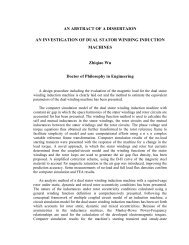CLIFFORD AND GRASSMANN HOPF ALGEBRAS VIA THE ...
CLIFFORD AND GRASSMANN HOPF ALGEBRAS VIA THE ...
CLIFFORD AND GRASSMANN HOPF ALGEBRAS VIA THE ...
Create successful ePaper yourself
Turn your PDF publications into a flip-book with our unique Google optimized e-Paper software.
Teaching<br />
Having a well developed CAS, it can be useful in teaching! Students can check<br />
their own prejudices by exemplifying them directly on a computer. This requires<br />
a stable code which does not allow for illegal input, etc. <strong>CLIFFORD</strong> ′ s<br />
code is stable while BIGEBRA still needs knowledge of the user because to<br />
gain speed, type and input checking is hardly done since it is time consuming.<br />
Hence, <strong>CLIFFORD</strong> (and with some restrictions BIGEBRA) can be effectively used<br />
in teaching Graßmann and Clifford algebras and cogebras. Students can make<br />
their own experiments and develop –given a CAS which is stable under silly<br />
input– a sound understanding of the mathematical structures in question.<br />
Teaching mathematics or physics using a CAS allows one to abstract from<br />
technical details on the first approach. However, if the goal is that students<br />
develop an understanding of the topic, they should be encouraged to recalculate<br />
by hand and to recode themselves. Otherwise no deep understanding will<br />
ensue. A good example how this can be achieved is [22].<br />
Experimental Mathematics<br />
Having the opportunity to deal with a CAS opens a field of experimental<br />
mathematics. This includes partly the other topics given above but it should<br />
not be underestimated due to its own dynamics. Exploring mathematics by<br />
doing particular experiments and by strengthening or weakenning one’s own<br />
assumptions is of extreme value as it allows one to enter a new mathematical<br />
field quickly and in a reliable way.<br />
Algorithmic Understanding<br />
We share a growing belief [11] that computer usage not only allows one to<br />
successfully complete non-trivial computations but also, through a development<br />
of algorithms, contributes to a better understanding of the problem. The<br />
so called algorithmic approach leads to achieving a computational proficiency<br />
that in turn leads to a deeper mastery of the subject on the theoretical level.<br />
2 The BIGEBRA package<br />
We concentrate in this article on BIGEBRA and its features which generally go<br />
beyond those of <strong>CLIFFORD</strong> and Maple. We assume that the reader is somewhat<br />
familiar with the syntax and features of Maple, see, e.g., [22], while <strong>CLIFFORD</strong><br />
is described in [3].<br />
The package loads with the following commands while the linear algebra package<br />
linalg is loaded for convenience only. <strong>CLIFFORD</strong> needs to be loaded first<br />
3
















